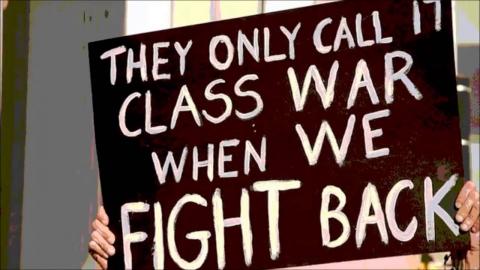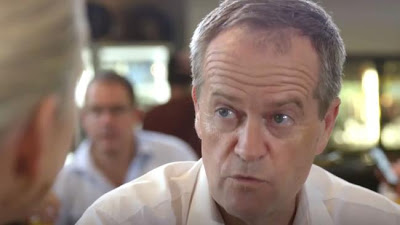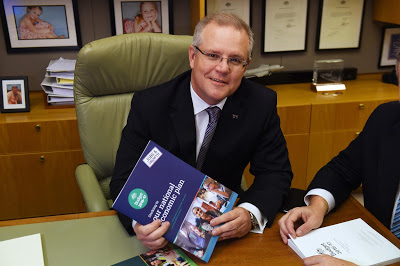The first (and possibly last) Scott Morrison Federal Budget is being widely misinterpreted as modest and non-controversial – playing to the theme of ‘living within our means’. Effectively token personal income tax cuts for those on high incomes are suggestive of Liberal Party priorities in the context where other income tax-payers experience no relief.
Further, increases in tax on tobacco may seem like a ‘safe bet’; but neither side of politics appears concerned at the distributive ramifications.
In the ‘big picture’ though, there are still big cutbacks implicit in this Budget that may escape voters’ eyes at a casual glance. Cuts in Medicare and Higher Education will undeniably lead to an intensification of user pays and privatisation over the course of a re-elected Turnbull LNP Government. The LNP is hoping to evade scrutiny by adopting some distributively-fair policies. But a thorough analysis reveals a Budget which retains too much from the disastrous 2015-16 Hockey austerity Budget.
And yet there are some aspects which are mildly encouraging.
Under the reforms foreshadowed by Treasurer, Scott Morrison, wealthy superannuants would no longer be able to “draw tax-free earnings from balances over $1.6 million.” The Government is also “planning to introduce a $500,000 lifetime cap on the amount of after-tax contributions a person can make, backdated to 2007.” Labor has criticised the “retrospective” nature of the policy, but the measure will still only bring in $2.9 billion over four years. Meanwhile, high income workers will also be hit with a lowering of the threshold at which the concessional rate of 30 per cent applies for payments into superannuation accounts. That is: lowered from a $300,000/year threshold currently to a threshold of $250,000. Other superannuation measures will subsidise low-income workers, and support the ‘topping up’ of low-income spouse’s accounts by a partner. Those measures are a move in the right direction.
But Sally Rose of ‘The Age’ also observes that without a crack-down on negative gearing these policies could simply drive more investors into property – contributing to an intensification of a housing bubble which already locks so many young families out of the market.
‘The Age’ also proclaims that Scott Morrison is ‘taking aim at the multinationals’, hiring 700 tax professionals to lead a crack-down on corporate tax-avoidance. Tax avoiders will face significant penalties. But the projected savings of $3.9 billion are highly optimistic at best, despite the projection that corporate tax evasion is costing over $30 billion a year.
What is more, while the Coalition’s ‘Youth Jobs’ initiative is a significant improvement on existing Work for the Dole programs, nonetheless it amounts to another form of labour conscription and exploitation. The good news is that the program links into the skills which may actually lead to work later down the track. The unacceptable side of the equation is that young workers will be paid a pitiful $100/week extra for working a 25 hour week. ‘The Age’ fears the policy may create “a conveniently revolving door for cheap labour.” The question is whether or not the opportunity for skills development will ‘break the cycle of unemployment’, or whether competition will simply increase for a limited pool of jobs (where there is only one job for every five job-seekers). This raises the question of whether government needs to intervene more directly with an industry policy that links skills with additional new jobs over the long-term.
There will be some additional money for schools and hospitals – but significant pain as well.
Medicare rebates will be frozen at $37 for six years, driving the erosion of the public health system, and heralding the introduction of steadily increasing co-payments. Prescription medicines will also increase in cost by $5 , and a user-charge will be added to Pathology services (eg: blood tests) adding up very substantially for those with chronic conditions for which medication and blood tests are non-negotiable.
The ‘Herald-Sun’ projects “$1.2 billon” in aged care cuts. ‘Pain management’ for residents in Aged Care will be cut-back on account of what is described as an “unsustainable” growth in expenses. (What price the amelioration of an elderly person’s suffering?). A crack-down on ‘false claims’ by Aged Care facilities is anticipated to bring in almost $500 million; but there is no recognition of the fact little can be done about quality of life and oppressively unfair user-pays without a very significant injection of new funds. By ‘quality of life’ I refer to a host of problems – from underpayment and under-staffing which impact on basic questions such as when residents are turned in their beds to avoid bedsores, or whether aged care workers can be certain residents are actually eating, or whether or not there is poor morale and a revolving door for skilled staff.. It also refers to the lack of things for residents to do ; of the terrible boredom, the lack of meaning, the lack of pleasant surrounds, and the lack of privacy. Finally it includes the need for a registered nurse on the premises 24/7 in the case of an emergency.
University fee-deregulation has been dumped for the time being; but big cuts remain in place – still begging the question of how the sector will cope. Likely options include further reductions in HECS (Higher Education Contribution Scheme) repayment thresholds to well below Average Weekly Earnings (AWE). Liberal arguments, here, that government and students need to spread the cost of degrees ’50/50’ deserve to be treated with healthy scepticism. Not only does business benefit from the skills acquired by students; but also the most equitable way of spreading the burden is through a progressively structured tax system. If repayments are to be geared to the actual financial benefit gained, then there is no better way to go. On the other hand, higher repayment rates for those on over $100,000/year could have a ‘progressive aspect’, and should not be considered in the same light as reductions in repayment thresholds and increases in repayment rates elsewhere.
Arguably students will be hit hard with debt in order to pay for big Corporate Tax Cuts. True to its mantra of ‘small government’, essentially the government is arguing it will ‘do more with less’. In reality, though, this adds up to ‘no new programs without cuts elsewhere’. Linking the National Disability Insurance Scheme to welfare-cuts, there will be cutbacks in pensions for new recipients amounting to $15/fortnight, and a push to reassess the pension eligibility of some 90,000 Disability Pensioners. For those already living in poverty this can impact with malnutrition, or exposure to the elements as the costs of heating and cooling become unsustainable.
The Government anticipates an economic transformation ‘beyond the mining boom’, yet while it is subsidising Defence jobs in the construction of subs and other hardware (inefficiently creating 3,600 jobs at a cost of about $50 billion), the death of Australia’s auto industry undeniably occurred under the Liberal Party’s watch, with perhaps 50,000 jobs lost directly and indirectly.
The goal of raising Defence expenditure to 2 per cent of GDP by 2020-21 remains: but if the Liberals want bipartisanship with Labor, here, they must ensure this is not at the expense of other important programs. If bi-partisanship is ‘in the nation’s interest’ the Liberals must disregard Ideological qualms and accept a small increase in ‘the size of government’ to lock in Defence commitments. And Australia’s military assets should always be reserved for the actual defence of Australia and its allies, and not in adventures and wars of aggression overseas (as with the Gulf War of Bush, Blair and Howard).
More generally the Budget is light on infrastructure construction. Hence the need to make tough decisions to ‘increase the size of government’ or make further painful and damaging cuts is ‘postponed’. Given infrastructure demands in transport, communications, energy and so on, it is a situation which cannot be sustained over the longer term.
‘The Age’ reports that Shorten Labor has responded with “$71 billion Budget Savings” of its own. This includes opposition to Turnbull’s tax cuts for corporations which will see the Company Tax rate reduced from 30% to 25% over ten years. Some analysts are anticipating an utterly unsustainable cost to the Budget of over $50 billion over ten years should this Turnbull policy be adopted. This should not be surprising given the Liberals’ track record of tax cuts for the wealthy and upper middle class (unsustainable because in the context of the mining boom) – and ultimately funded by austerity elsewhere, impacting upon those on middle and lower incomes, as well as those mired in poverty.
Here, the Turnbull mantra of ‘Jobs and Growth’ has no substance. While low Company Tax rates may attract some investors, the other side of this decision could be neglect of services and infrastructure necessary to sustain economic activity. That might mean less ‘jobs and growth’ and not more. And while a small proportion of the cuts will flow through to workers, most of the tax cuts will simply be pocketed by business. Under this scenario, If essential infrastructure and services are not to be neglected the only alternatives include privatisation and user pays, or for taxpayers to ‘pick up the tab’ elsewhere.
None of those options are desirable or fair. But this scenario also raises other problems such as reduced workers’ consumption power, and the inferior cost structures involved in the private finance and operation of profit-geared services and infrastructure. The Liberal obsession with ‘small – government’ with ‘no exceptions’ betrays an impractical posture where good sense is sacrificed for Ideology.
In light of what it once called a ‘debt and deficit disaster’ the Liberals’ projected Company Tax cuts are being dismissed as fiscally irresponsible by Shadow Treasurer Chris Bowen.
Somewhat disappointingly, though, Shorten has argued Labor will oppose the Liberals’ $1.6 million cap’ on superannuation savings which attract the concessionary tax rate. Again: The argument is that the policy would have ‘retrospective’ elements, and hence is opposed ‘on principle’. Some corners of the media are speculating that the idea may be to ‘wedge’ the Liberals on their own core constituencies (ie: the wealthy and upper middle class). Nonetheless Labor’s own policy seeks to remove superannuation concessions from retirees already living on superannuation-streamed incomes of $75,000/year and over. Labor expects this will impact upon 60,000 superannuation account holders with accounts valued at over $1.5 million. But Labor is also reducing the threshold for the ‘high income super charge’ (HISC) from $300,000 to $250,000, affecting 110,000 people, and diluting their concessional tax rate on their contributions by a flat 15% (ie: a 15% concession down from 30%).
In April 2016 Shorten and Chris Bowen had argued that this, and measures on corporate tax evasion would save $20 billion over a decade. Again: that is in the context of superannuation tax concessions soon costing as much as $50 billion EVERY YEAR, and Corporate Tax evasion costing over $30 billion EVERY YEAR (according to Labor Senator, Sam Dastyari).
It is clear now that no-one is willing to truly ‘get serious’ on the reform of superannuation concessions and tax. On Superannuation Concessions alone Labor needs to target a ‘broader base’; hitting the upper middle class as well. While the upper middle class may not be as privileged as the ‘top 1 per cent’, nonetheless it is not fair for the remainder of society, including low and middle income workers, to subsidise their lifestyles. A better policy here could free tens of billions for investment elsewhere in services, infrastructure, and welfare.
But despite this there remain very-encouraging Labor policies as well; which will still see Labor outstripping the Liberals on distributive justice and the public interest.
The Gonski education reforms will be implemented, as will the National Disability Insurance Scheme (NDIS), and the construction of the National Broadband Network with superior Fibre-to-the-Home technology.
Exploitation of students (and taxpayers) by dodgy private vocational education outfits will be cracked-down upon with an $8000/cap per student, and a re-emphasis on TAFE. This is estimated as saving $6 billion over a decade.
Shorten’s Labor reforms limiting access to Negative Gearing to new investments, as well as restricting Capital Gains Tax concessions could save over $7 billion a year. And a Deficit Levy on high income earners will be made permanent, saving $16 billion over a decade. The Negative Gearing policy especially should lead to more-affordable housing and more new housing. So while there is ‘room to improve’, this is a step in the right direction.
By leading the debate Shorten has forced Turnbull and Morrison to adopt some ‘Labor-esque’ Budgetary policies. To the extent to which Labor is setting the tone for the election this has to be welcomed.
On the other hand while Labor is condemning the far-from equitable cuts that Morrison has projected elsewhere in the Budget, Shadow Treasurer Chris Bowen also points to the maintenance of “higher taxes” under the LNP than any time during which Labor was in Government.
This can partly be traced to priorities. For example the $50 billion Defence contract to build 12 new subs; and the decision to raise overall Defence expenditure to 2% of GDP. But at the same time: eventually Labor needs to confront the fact that it cannot afford its social agenda without raising tax significantly on those who can really afford it.
As considered earlier, Aged Care requires many billions new expenditure annually to wind back regressive user pays structures, and improve the quality of care and infrastructure.
And Mental Health spending needs to rise absolutely and proportionately with billions new funding as well. There is a truly shameful National Emergency whereby the mentally ill are on average dying 16 years earlier than the general population, and those with Schizophrenia (maybe 300,000 Australians) are dying 25 years earlier than the general population average. Catherine Armitage of ‘The Age’ (‘A kind of creeping euthanasia’, 11/4/16) has pointed out that 9000 Australians with a serious mental illness are dying prematurely as a consequence of this situation every year. This far outstrips the road toll and suicide rate combined several times over. Both Labor and the Liberals need to support fully-funded government programs to ‘Close the Gap’ on life expectancy for the mentally ill, much as there are programs to ‘Close the Gap’ for Indigenous Australia.
Again: The Liberal obsession with ‘small- government’ with ‘no exceptions’ betrays an impractical posture where good sense is sacrificed for Ideology. Labor needs to decisively reject this Ideology and embrace reforms which reject ‘small government’, and instead promote social solidarity, collective consumption, social insurance, truly progressive taxation and so on. The Nordics already demonstrate what is possible. But to be serious even a ‘gradualist’ posture by Labor – aiming to emulate the Nordics over the course of two or three decades – should see social expenditure and investment rise by tens of billions under Shorten Labor.
Labor is providing a clear choice in this election: on Gonski, tax reform, NBN and NDIS. But we need to do better. In Australia we should no longer ‘take small government for granted’. With the end of the mining boom, we need to reform tax just to ‘stand still’ on social services, infrastructure and welfare. Tax reform is ‘the price we pay for civilisation’. And a progressive policy trajectory necessarily entails ongoing, serious and cumulative reforms on this front.
This article was originally published on the ALP Socialist Left Forum.
Like what we do at The AIMN?
You’ll like it even more knowing that your donation will help us to keep up the good fight.
Chuck in a few bucks and see just how far it goes!
Your contribution to help with the running costs of this site will be gratefully accepted.
You can donate through PayPal or credit card via the button below, or donate via bank transfer: BSB: 062500; A/c no: 10495969


















